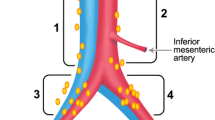Abstract
Purpose
Of those patients who undergo open surgery for a suspicion of malignant transformation of endometrioma (MTOE) due to solid nodule enhancement identified by contrast-enhanced magnetic resonance imaging (MRI), some benign endometrioma cases are included. The aim of this retrospective study was to determine the value and diagnostic accuracy of positron emission tomography/computed tomography (PET/CT) using 18-fluoro-2-deoxy-d-glucose (FDG) to differentiate between MTOE and endometrioma.
Patients and methods
We retrospectively analyzed 1599 consecutive patients who underwent laparoscopic surgery for the diagnosis of endometrioma preoperatively and 31 patients who underwent open surgery for a suspicion of MTOE preoperatively from January 2003 to December 2011. We analyzed the age, serum CA125 levels, and MRI findings of the patients and calculated the optimal cut-off value for PET/CT using receiver operating characteristic curve analysis.
Results
Of the 1,599 patients who underwent laparoscopic surgery for a suspicion of endometrioma preoperatively, malignancy was identified in one (0.062 %) patient. Of the 31 patients who underwent open surgery for a suspicion of MTOE preoperatively, 11 were diagnosed with endometrioma (false positive group) and 20 with MTOE stage I (positive group). Age, tumor size, presence of shading on MRI and maximum standardized uptake values (SUVmax) on PET/CT were significantly different between the two groups. A SUVmax cut-off >4.0 is capable of excluding endometrioma cases, with 75 % sensitivity and 100 % specificity (area under the curve 90 %).
Conclusion
PET/CT is a good diagnostic tool for MTOE using the optimal SUVmax cut-off of 4.0 (75 % sensitivity and 100 % specificity).


Similar content being viewed by others
References
Harada T, Iwabe T, Terakawa N (2001) Role of cytokines in endometriosis. Fertil Steril 76:1–10
Kobayashi H, Sumimoto K, Moniwa N et al (2007) Risk of developing ovarian cancer among women with ovarian endometrioma: a cohort study in Shizuoka, Japan. Int J Gynecol Cancer 17:37–43
Tanaka Y, Yoshizako T, Nishida M et al (2000) Ovarian carcinoma in patients with endometriosis: MR imaging findings. Am J Roentgenol 175:1423–1430
Scott RB (1953) Malignant changes in endometriosis. Obstet Gynecol 2:283–289
Taniguchi F, Harada T, Kobayashi H et al (2014) Clinical characteristics of patients in Japan with ovarian cancer presumably arising from ovarian endometrioma. Gynecol Obstet Invest 77:104–110
Kawaguchi R, Tsuji Y, Haruta S et al (2008) Clinicopathologic features of ovarian cancer in patients with ovarian endometrioma. J Obstet Gynaecol Res 34:872–877
Kobayashi H, Sumimoto K, Kitanaka T et al (2008) Ovarian endometrioma-risks factors of ovarian cancer development. Eur J Obstet Gynecol Reprod Biol 138:187–193
Nam EJ, Yun MJ, Oh YT et al (2010) Diagnosis and staging of primary ovarian cancer: correlation between PET/CT, Doppler US, and CT or MRI. Gynecol Oncol 116:389–394
Karlan BY, Hawkins R, Hoh C et al (1993) Whole-body positron emission tomography with 2-[18F]-fluoro-2-deoxy-d-glucose can detect recurrent ovarian carcinoma. Gynecol Oncol 51:175–181
Rieber A, Nussle K, Stohr I et al (2001) Preoperative diagnosis of ovarian tumors with MR imaging: comparison with transvaginal sonography, positron emission tomography, and histologic findings. Am J Roentgenol 177:123–129
Lerman H, Metser U, Grisaru D et al (2004) Normal and abnormal 18F-FDG endometrial and ovarian uptake in pre– and postmenopausal patients: assessment by PET/CT. J Nucl Med 45:266–271
Nishizawa S, Inubushi M, Okada H (2005) Physiological 18F-FDG uptake in the ovaries and uterus of healthy female volunteers. Eur J Nucl Med Mol Imaging 32:549–556
Author information
Authors and Affiliations
Corresponding author
Ethics declarations
Conflict of interest
The authors declare that there are no conflicts of interest.
About this article
Cite this article
Kusunoki, S., Ota, T., Kaneda, H. et al. Analysis of positron emission tomography/computed tomography in patients to differentiate between malignant transformation of endometrioma and endometrioma . Int J Clin Oncol 21, 1136–1141 (2016). https://doi.org/10.1007/s10147-016-1013-x
Received:
Accepted:
Published:
Issue Date:
DOI: https://doi.org/10.1007/s10147-016-1013-x




